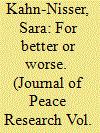|
|
|
Sort Order |
|
|
|
Items / Page
|
|
|
|
|
|
|
| Srl | Item |
| 1 |
ID:
090093


|
|
|
|
|
| Publication |
2009.
|
| Summary/Abstract |
The measured data of global solar radiation on a horizontal surface, as well as the number of sunshine hours, mean daily ambient temperature, maximum and minimum ambient temperatures, relative humidity and amount of cloud cover, for Jeddah (latitude 21° 42?37?N, longitude 39° 11?12?E), Saudi Arabia for the period 1996-2006 are analyzed. The data are divided into two sets. The sub-data set 1 (1996-2004) are employed to develop empirical correlations between the monthly average of daily global solar radiation fraction (H/H0) and various meteorological parameters. The nonlinear Angström type model developed by Sen and the trigonometric function model proposed by Bulut and Büyükalaca are also evaluated. New empirical constants for these two models have been obtained for Jeddah. The sub-data set 2 (2005, 2006) are then used to evaluate the derived correlations. Comparisons between measured and calculated values of H have been performed. It is indicated that, the Sen and Bulut and Büyükalaca models satisfactorily describe the horizontal global solar radiation for Jeddah. All the proposed correlations are found to be able to predict the annual average of daily global solar radiation with excellent accuracy. Therefore, the long term performance of solar energy devices can be estimated.
|
|
|
|
|
|
|
|
|
|
|
|
|
|
|
|
| 2 |
ID:
168299


|
|
|
|
|
| Summary/Abstract |
Energy efficiency is widely recognized as a cost-effective strategy to meet energy demand. The U.S. energy service company (ESCO) industry generates significant energy savings and other benefits through installing and maintaining energy efficiency, renewable and other types of projects. In this study, we evaluate factors that may explain trends in the economic performance of U.S. ESCO projects by analyzing project level data for ∼7000 U.S. ESCO industry projects. We find that real project investment levels normalized for floor area have increased over time in ESCO projects across market segments. However, the dollar value of energy savings and other reported benefits have not kept pace with increases in real project investment levels over time. The latter have increased 100%–500% in various market segments from 1990 to 2017. We conduct an econometric analysis to decompose the drivers of these underlying trends. Number of measures and a changing mix of conservation measures are the primary factors that correlate with the long-term increase in project investment levels. However, our analysis is only able to account for less than 50% of the increase in real investment levels. We discuss additional factors, and conclude discussing policy implications and outlining long-term research needs.
|
|
|
|
|
|
|
|
|
|
|
|
|
|
|
|
| 3 |
ID:
178725


|
|
|
|
|
| Summary/Abstract |
Does it matter whether human rights (HR) shaming is accompanied by acknowledgments of reforms and progress? Do such acknowledgments weaken or strengthen the impact of shaming? Rulers decide whether to oppress or to comply with HR treaty obligations by considering what compliance entails and by weighing the internal and external costs and benefits of oppression. Research shows that HR shaming alters such considerations and is associated with changes in HR protection levels. Can the same be said of faming? This article examines three forms of HR reporting: faming, which focuses on positive developments; shaming, which focuses on problematic HR practices; and scrutiny, which combines shaming and faming. The article analyzes the association between shaming, faming, and scrutiny by UN treaty bodies, on the one hand, and oppression on the other. The potential associations are conceptualized as mitigation, backsliding, and specification. The analysis finds that shaming with no faming and faming with no shaming are each negatively associated with HR protection. Scrutiny, the combination of shaming and faming, is positively associated with subsequent HR protection levels, and the higher the level of scrutiny the higher the subsequent level of HR protection. The article argues that the reason for this association is that the combination of shaming and faming helps policymakers understand how to properly implement their treaty obligations and how to improve HR protection. The article draws policy and theoretical implications including the need for balanced and detailed HR reporting, and the importance of learning in HR advocacy.
|
|
|
|
|
|
|
|
|
|
|
|
|
|
|
|
| 4 |
ID:
176812


|
|
|
|
|
| Summary/Abstract |
Information campaigns promoting sustainable technology adoption are common. However, knowledge about their effects is limited. In this study, the effect of a Swedish information campaign for solar photovoltaics (PV) adoption is evaluated quantitatively. The campaign took place in Sweden in 2017 and was directed towards homeowners. 41% of all Swedish municipalities participated, creating a ‘treatment’ and a ‘control’ group. As dependent variables, we used applications and approvals for a nation-wide PV subsidy scheme. Few Swedish PV installations have historically occurred outside of the subsidy scheme, which is quite accessible and offers a substantial rebate. Thus, the data were assumed to correspond well with actual installations. Hierarchical linear regression, with a set of control variables, was used. We found that campaign participation was associated with a 29% increase in submitted and approved subsidy applications. Thus, we conclude that the information campaign had a significantly positive effect on PV adoption rates, and that policy makers in other countries with limited PV penetration could launch similar campaigns to elevate PV adoption rates.
|
|
|
|
|
|
|
|
|
|
|
|
|
|
|
|
|
|
|
|
|